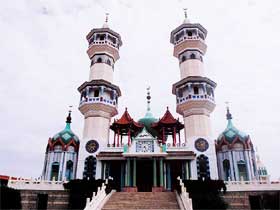| Muslim Architecture | |||
|
|||
|
Ningxia is home to ethnic Hui people who are typically distinguished by their practice of Islam. Hui architecture features in mosques, Hui churches, qubbahs (Islamic shrine complex) and Muslim-style dwellings. Statistics show that there are more than 3,000 mosques, 10 qubbahs and three Hui churches spread throughout the Hui communities in Ningxia.
A mosque is a place of worship for Muslims. The earliest mosques in Ningxia date back to Yuan Dynasty when the area was under Mongol domination after Genghis Khan conquered Yinchuan early in the 13th century. Throughout the Ming and Qing dynasties, mosques grew both in quantity and size.
Qubbah, or Gongbei, a term used by the Hui people in Northwest China, refers to a shrine complex centered around a grave of a Sufi master, typically the founder of a menhuan (a Chinese Sufi sect, or a "saintly lineage"). The grave itself usually is topped with a dome. A Hui church is a place for an Islamic master in Northwest China to worship, preach, lecture and live. Ningxia Muslim dwellings, generally made in earth, assimilate the workmanship of the traditional architecture of the Han people but attain their distinctive Muslim flavor through Islamic wall decorations. |
| Tools: Save | Print | E-mail |
|
| Comment |







